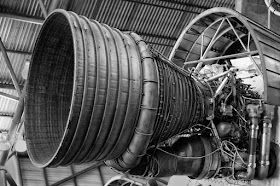Wednesday, 27 December 2017
Wednesday, 15 November 2017
Advanced Solar Energy in Space: Part I
Solar Thermal Rockets can be efficient and have high performance. However, they remain temperature-limited to an exhaust velocity of 12km/s.
How do we surpass this limit?
Monday, 23 October 2017
Wednesday, 18 October 2017
SpaceX SFR: Small Falcon Rocket
The Small Falcon Rocket is a scaled down alternative to SpaceX's Big Falcon Spaceship that fits on top of existing Falcon 9 boosters.
We will discuss the advantages and disadvantages of such a design.
Thursday, 12 October 2017
Anti-Orbit Laser Submarines
Laser-equipped nuclear-powered submarines are the perfect last line of defense against an attacking force in orbit.
Monday, 11 September 2017
Low Earth Orbit Atmospheric Scoops
The rocket equation is often described as tyrannical. Low exhaust velocity chemical rockets that are used today need payloads to be mounted on towers of propellant to reach extraterrestrial destinations.
Wednesday, 30 August 2017
Wednesday, 2 August 2017
Wednesday, 19 July 2017
All the Radiators
Every spaceship will have radiators. Energy such as sunlight, reactors, habitats and rocket engines accumulates as heat unless it is removed through radiation.
We will look at how this critical component works and then at existing, future and possible designs.
We will look at how this critical component works and then at existing, future and possible designs.
Tuesday, 27 June 2017
Sunday, 11 June 2017
Sunday, 21 May 2017
Nuclear EFP and HEAT
A follow-up to the popular Casaba Howitzer post, we now look more closely at the concept of nuclear shaped charges in both Explosively Formed Projectile and High-Explosive Anti-Tank (Monroe effect) forms.
Friday, 12 May 2017
Thursday, 20 April 2017
Interstellar Trade is Possible Part III: Threats, Strategy and Evolution
Interstellar trade does not happen in a vacuum.
Wednesday, 12 April 2017
Tuesday, 21 March 2017
Interstellar Trade Is Possible
In this post, we will detail a method for developing interstellar trade using near-future technologies and commercially realistic requirements. We will then look at the various outcomes, challenges and development models that will follow the first interstellar operation.
There is now a Summary at the end of the post.Thursday, 2 March 2017
Laser Launch into Orbit
In this post, we will look at laser launch systems, how they would look like and perform, and how they might be applied to reach orbit and beyond.
Tuesday, 21 February 2017
Tuesday, 24 January 2017
Boosted Orbital Tether - a fishing line in space!
The Boosted Orbital Tether is a less extreme version of the space elevator. A rocket is launched on a vertical trajectory to an altitude of several hundred kilometres. An orbiting mass drags a line and hook to catch the rocket and spends momentum to bring the rocket into orbit.
Let's look at the concept in more detail.
Let's look at the concept in more detail.
Friday, 20 January 2017
Expansion-cooled, Curved-nozzle stealth rocket
Here, we will look at a design for engines that can accelerate a spacecraft without producing detectable emissions. It is best fitted to a stealth spaceship described in 'The Hydrogen Steamer: Stealth Spaceship Concept'.



















